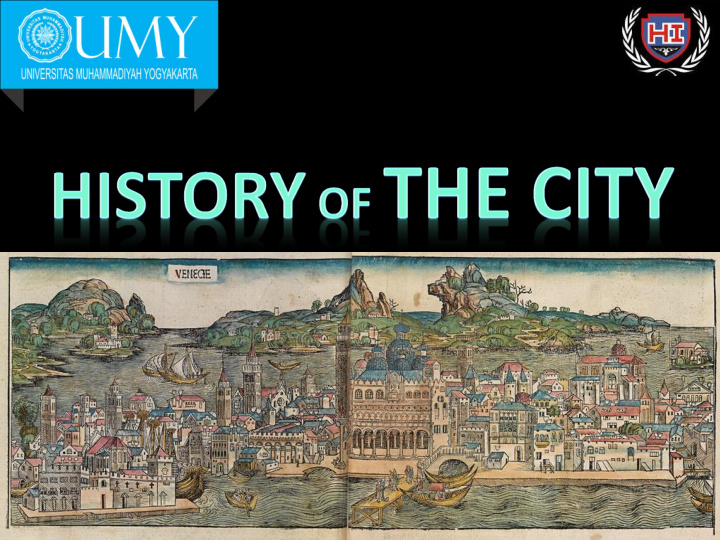



Jundi Faza Hubbalillah (20140510057) Tri Azmi Khairunnisa (20140510077) Harits Surya Pahlawan (20140510092) Adriana Fitri Nugrahani (20140510137) Dimas Dwi Mahendra Diputra (20140510141) Abi Dzar El Ghiffari Wibisono (20140510149) IC - A Pittra Amrullah (20140510265) Nandyani Siska Pawestri (20140510336)
Definition 21 st Middle Early Industrial Ancient Century Ages Ages Modern City in Europe and Islam
City is also primarily used to designate an urbansettlement with a large population. City, large centre of population organized as a community. City
In the study of the ancient world a City is generally defined as a large populated urban center of commerce and administration with a system of laws and usually, regulated means of sanitation. ANCIENT All of cities in ancient era were under monarchy state.
Most of the city in ancient era emmerge since 4000 BC-10 BC. ANCIENT Mosque of Abraham in Aleppo Glazed-brick Panels in Susa
I NFRASTRUCTURE The public needs of MIDDLE AGES structure are still in a basic shape. HOW WAS THE CITY LIKE The city parts of that were not all that pretty, but some are also beautiful.
ARCHITECTURE Romanesque style was characterized by round arches, MIDDLE AGES horizontal lines and thick walls, while Gothic style was notable for the pointed arch or flying buttress, and for tall and thin walls with many windows. SOCIAL LIFE Feudalism became the predominant social system in most parts of Europe and Asia by the end of the 11th century.
POLITICAL MATTERS MIDDLE AGES Falled with Emperors, kings, lords, even sometimes a small council.
EARLY MODERN • Cities were bound to several laws about administration, finances, and urbanism. • Cities acted as nuclei for long-distance trading networks. • Cities with great power were fighthing each other (war). • European cities were particularly unhealthy.
EARLY MODERN Architecture
INDUSTRIAL AGES The growth of modern industry from the late 18th century onward led to massive urbanization and the rise of new great cities.
By early 19th century, london had INDUSTRIAL AGES become the largest city in the world with population of over a million, while paris rivaled the well-developed regionally traditional cities of baghdad, beijing, istanbul, and kyoto. Crystal Palace in London
INDUSTRIAL AGES
The 21st century is the current century or the Common Era. It began on January 1, 21 st CENTURY 2001, and will end on December 31, 2100. In 2008, for the first time in history, more than half of all human beings lived in cities. Although megacities with populations over 10 million, such as tokyo, mexico city, and sao paulo, are widely recognize, most urban growth is taking place in so-called medium- size cities of between 1 million and 5 million. This reality changes how policymakers in every sphere can pursue their goals.
In Building structure side, the houses 21 st CENTURY in 21st doesn’t had much different with the houses in 20st century, but the houses in 21st mostly are larger upward, the rest its just improving the size and colour. House in 21 st Century House in 20 th Century
21 st CENTURY 3XN (2013) COPENHAGEN, DENMARK SANTIAGO CALATRAVA AND FELIX CANDELA (2005) VALENCIA, SPAIN
ROME Architecture: • Many buildings in Rome were built around the forum. • Roman houses were divided into two kinds, the rich citizens' houses ad the poor citizens' houses. Infrastructure : a. The aqueducts: were construct underground todeliver waterfrom surounding river to the city b. The roads: were made from stone and soil to sucessedthe interest of roman ekspansion
The picture of roman aqueducts => <= The picture of roman roads
BAGHDAD Architecture • Baghdad was built in a circular form. Infrastructure
Conclusion The city is developed by it’s people, and the people continue to evolve and be more sophisticated. So the more civilized and advance people are, the more civilized and advance the city will be.
Thank You For Your Attention
Recommend
More recommend